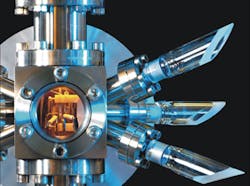Refined laser setup advances ytterbium-ion-based time measurement
Middlesex, England--At the National Physical Laboratory (NPL), physicists have implemented an improved diode-based probe laser that allows an ytterbium-ion atomic clock to operate for extended periods of time at its required frequency.1 This may eventually result in an optical-frequency-based ytterbium-ion clock that could supersede the conventional microwave-frequency-based cesium-ion clock as the world's most accurate clock.
The researchers have used their setup to make a measurement of the highly forbidden octupole transition frequency in an ytterbium ion accurate to one part in 1015. The measurement agrees with a similar measurement made by the Germany's national metrology institute Physikalisch-Technischen Bundesanstalt (PTB; Braunschweig) and published soon after the NPL paper, with an uncertainty of 0.8 parts in 1015.
The definition of the second comes from the time taken for 9,192,631,770 microwave-frequency oscillations in a cesium atom. The recent research at NPL measured that during one second, the ytterbium ion clock underwent 642,121,496,772,646.22(67) oscillations, corresponding to a tick rate nearly five orders of magnitude higher than in cesium. It is thought that the uncertainty can be further reduced by decreasing the impact of any drift in the magnetic field. One way of doing this would be to place a magnetic shield made from mu-metal (a nickel-iron alloy with a high magnetic permeability) around the ion trap.
By introducing the magnetic shielding and making several other identified improvements, the uncertainty for the ytterbium standard could be further reduced to below the level of one part in 1017.
REFERENCES:
1. S. A. King et al., New J. Phys. 14, p. 013045 (2012).
2. N. Huntemann et al., Phys. Rev. Lett. 108, p. 090801 (2012)

John Wallace | Senior Technical Editor (1998-2022)
John Wallace was with Laser Focus World for nearly 25 years, retiring in late June 2022. He obtained a bachelor's degree in mechanical engineering and physics at Rutgers University and a master's in optical engineering at the University of Rochester. Before becoming an editor, John worked as an engineer at RCA, Exxon, Eastman Kodak, and GCA Corporation.
